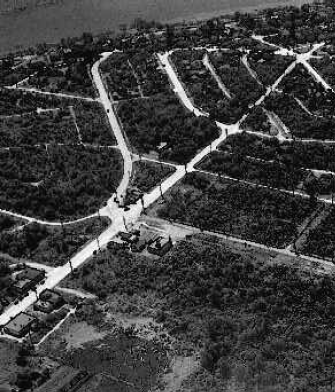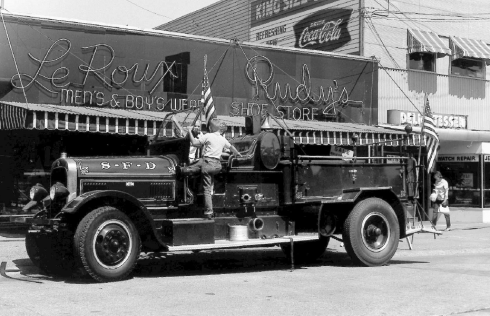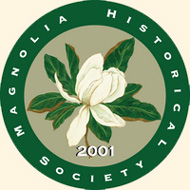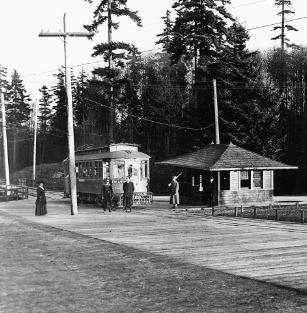By Jeffrey Cunningham
President of the Magnolia Historical Society
December 17th, 2014
Then: The area that came to be known as the Magnolia Village started out as a small knot of shops close to Wolfe Creek in the south part of Magnolia in the 1920’s. Aleua Frare talks about the first businesses in the Village in her Magnolia Yesterday and Today, She talks most especially about the Magnolia Hardware, started by Roy Chambers in 1927. It was two story building, with the family’s living quarters on the upper level. This store has had a few different locations and names, but today it still exists as Ace Hardware, the oldest continuously operating business in the Village. During that first decade the Village was one block of McGraw Street. Joan Santucci tell us in her essay simply titled “The Village” in Magnolia: Memories and Milestones, that aside from the hardware store, there were only four other businesses: a pharmacy, grocery store, gas station and real estate office. According to Gary McDonald’s article “Fill ‘Er Up” in Magnolia: Making More Memories, one of the key reasons why businesses started to develop and do well here was because the of new Garfield Street Bridge being completed in 1929. After the bridge the focus of traffic coming from the downtown was funneled into the south part of Magnolia, away from the fort.

An early aerial view of the village–looking southwest across W. McGraw at 34th Ave W.
Santucci says that by the 1940’s, in spite of WWII, the area was flourishing and this is the time that it came to be known as “the Village.” This can be seen in that many stores took the word “Village” in their names at this time: Village Auto Service, Village Beauty Salon, Village Cleaners, Village Grill and Village Variety Shop. This list also shows the level of diversity and specialization that the growing collection of businesses had. As the population of Magnolia grew during these years the Village further expanded and one could find any kind of retail establishment imaginable: drug stores with soda fountains, grocery stores, bakeries, jewelry stores, radio repair stores and various small offices. The Village has had many restaurants over the years, but the one that seems to get talked about the most is GG’s, which originally started as Tenny’s in the 1940’s. It is today Szmania’s on McGraw and 34th Avenue. Leroux’s Men and Boys Wear opened in 1948 and still exists in the same location. Also opened in 1948, is the much talked-about Magnolia Theater, where Chase Bank is today. Around the same time, the Magnolia Bowl came into existence. These two locales caused great excitement to young and old alike. They provided entertainment for a generation of Magnolians, but were unable to survive past the 1970’s. It seems that during this time the Village seems to calm down a bit. This was around the time that my dad, Larry Cunningham, moved to Magnolia. He had always said that back then “you could fire a cannon in the Village and no one would notice.”

A look at the Village during the 1950’s
I have a seemingly infinite number of memories and stories of the Village growing up in the 90’s. From the time we were old and responsible enough to go to the Village by ourselves to the time we had cars, walking or riding our bikes to the Village was one of our only pastimes. Every weekend my friend and I would walk down to the Village and use our Magnolia News paper route money to buy pop and candy from Bartell’s. I seem to remember, although it was a little bit before my time, a video arcade game at Godfather’s Pizza, which is the present-day location of Pronto Pizza. I can remember certain events from my early childhood, such a trick-or-treating around at all of the businesses, having roast beef sandwiches and apple cider at the Holiday Open House and the summer Sidewalk Sale. My best summer memories of the Village are of volunteering at Summerfest in high school, fooling around and probably causing more trouble than actually doing work. Subway was an important hangout because it was, and remains today, the only fast food restaurant on the bluff. It would be hard to count up all of the countless hours spent with friends as a teenager at Crazy Mike’s Video (later a franchise of the national chain Hollywood Video) on McGraw and 32nd Avenue. Of course this and the other video stores in Magnolia and Interbay have fallen victim to the advent of Netflix, Redbox and On Demand movies. The site is now an Umpqua Bank. Crazy Mike’s was the closest thing we had to a real movie theater, which, according to Frare, closed in 1974, about a decade before we were born.
Now: Today the Village is a bustling center of commerce and activity. The Village is the setting of many events throughout all seasons: Winterfest, a thriving summer Farmer’s Market, Summerfest, an annual Car Show and many more. Now, as always, the Village has reflected the signs of the times. During the postwar building boom in the 1940’s lots of real estate offices and banks appear for the first time. In the 1960’s the automobile conquered the cities and suburbs of America, thus we witnessed gas stations springing up (seven at one time). Now we see an intersection in the Village (33rd and McGraw) where you can get coffee on all four corners. In spite of this almost sounding like some sort of joke contrived to poke fun at Seattle, all of these coffee vendors seem to appeal to their own niche and do well. Also emerging about half a decade ago were condominiums. This is by no means on the scale of neighborhoods such as Ballard, but a few complexes have surfaced in former parking lots.
In 2000 Joan Santucci writes: “Today’s Village is definitely not just somewhere to do business, but rather a dynamic gathering spot where Magnolians can meet and greet, and enjoy themselves while running necessary errands.” It seems like every time I go to the Village, I run into someone I know. It is the place that people can conveniently get the things they need, but it has also always been the heart of Magnolia as a neighborhood. Looking back on all of the accounts I have read and the stories I have heard, this is how most people think of the Village. This is why the Magnolia Historical Society chose McGraw Street (between 33rd and 32nd Avenues) for the site of their sculpture recounting the history of Magnolia. This was erected in 2011, to commemorate the 10th anniversary of the Society. Indeed, throughout its history, as well as today, no other place in Magnolia so keenly evokes such a sense of community as does the Magnolia Village.



